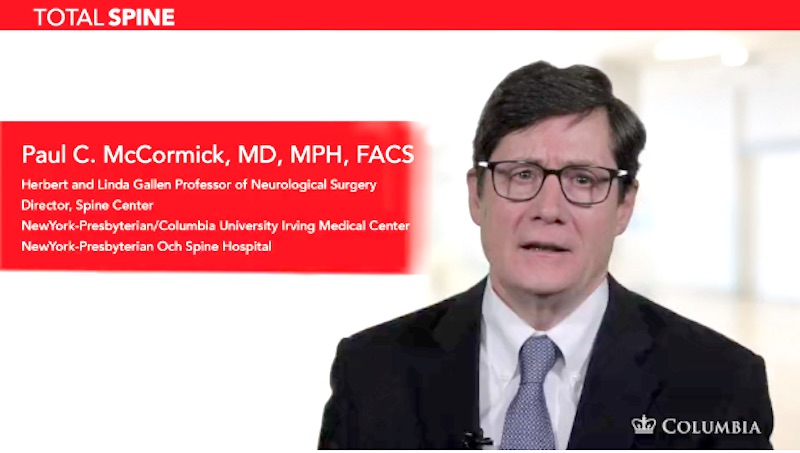| Header | Text |
| Summary | Osteomyelitis is an infection in the bone.
Osteomyelitis can occur in any bone. In children, it is most common in the long bones of the legs and upper arms. In adults, osteomyelitis most commonly affects the bones of the spine (the vertebrae). At The Spine Hospital at The Neurological Institute of New York, we specialize in osteomyelitis in the spine, or vertebral osteomyelitis.
Most cases of vertebral osteomyelitis occur in the lumbar spine (lower back). The next common site is in the thoracic spine (mid- and upper back), followed by the cervical spine (neck). Osteomyelitis may also occur in the sacrum (base of the spine).
The infection can be caused by bacteria, fungi, or other organisms. Osteomyelitis can be either acute (short-term) or chronic (long-term).
|
| Symptoms | Symptoms associated with vertebral osteomyelitis will depend on the location and severity of the infection. It may cause any of the following symptoms:
- Back pain (rare, especially in healthy, young patients)
- Unexplained weight loss
- Excessive sweating
- Fever
- Chills
- Fatigue
- Swelling, redness, and warmth around the area of infection
- Pain around the area of infection
- Torticollis (the inability to straighten out one’s neck) when the infection is in the cervical spine
Patients with chronic osteomyelitis may report bone pain, tenderness, and draining abscesses around infected bone for long periods of time (months to years).
Rarely, vertebral osteomyelitis may affect the nerves in the spine. If the infection travels into the spinal canal, this can result in an epidural abscess. Depending on how extensive the infection is and what portion of the spine is involved, additional conditions and symptoms may develop. If an epidural abscess is present in the cervical (neck) or thoracic (upper back) portions of the spine, paralysis can occur in the legs or in both the arms and legs. If the epidural abscess is present in the lumbar (lower) portion of the spine, it can result in cauda equina syndrome. Cauda equina syndrome results from the compression (squeezing) of the cauda equina–the sac of nerves and nerve roots at the base of the spinal cord. It is a rare but serious disorder, and a medical emergency.
|
| Causes and Risk Factors | Osteomyelitis is commonly caused by bacteria such as Staphylococcus aureus and Pseudomonas aeruginosa. Osteomyelitis can also be caused by fungus and mycobacteria.
Osteomyelitis can develop in a variety of ways:
- Through the bloodstream: The infection can begin in one part of the body and travel through the bloodstream to the bone.
- Infected tissue or an infected prosthetic joint following a surgery or injury.
- Open wounds: The infection may spread to a bone from infected skin (skin sore), muscles, or tendons that are in close proximity to the bone.
Risk factors for developing osteomyelitis include the following:
- Compromised immune system [for example, diabetes mellitus, immunosuppressive medications given to those who have undergone an organ transplant, long-term use of corticosteroids, malnutrition, chemotherapy, acquired immune deficiency syndrome (AIDS)]
- Hemodialysis
- Poor blood supply
- Recent injury
- Use of injected illegal drugs (Use of unsterilized needles can increase the risk of introducing bacteria into the blood and as a result bone)
- Having undergone a splenectomy (surgery to remove the spleen)
|
| Tests and Diagnosis | If a patient presents with symptoms associated with osteomyelitis, the surgeon may order the following tests:
- Blood tests:
- Complete blood count (CBC) – The doctor will draw blood to run a complete blood count (CBC) to determine if there is an infection in the body. If an infection is present, the number of white blood cells will be elevated. This is because white blood cells attack and destroy the organisms causing the infection.
- Erythrocyte sedimentation rate (ESR) – the doctor will draw blood to run an ESR to determine how much inflammation is in the body. ESR is useful in detecting a bone infection.
- C-reactive protein (CRP) – the doctor will draw blood to run a CRP to determine how much inflammation is in the body. CRP is useful in detecting an infection.
- X-ray (also known as plain films) –test that uses invisible electromagnetic energy beams (X-rays) to produce images of bones. Soft tissue structures such as the spinal cord, spinal nerves, the disc and ligaments are usually not seen on X-rays, nor on most tumors, vascular malformations, or cysts. X-rays provide an overall assessment of the bone anatomy as well as the curvature and alignment of the vertebral column. Spinal dislocation or slippage (also known as spondylolisthesis), kyphosis, scoliosis, as well as local and overall spine balance can be assessed with X-rays. Specific bony abnormalities such as bone spurs, disc space narrowing, vertebral body fracture, collapse or erosion can also be identified on plain film X-rays. Dynamic, or flexion/extension X-rays (X-rays that show the spine in motion) may be obtained to see if there is any abnormal or excessive movement or instability in the spine at the affected levels.
- Magnetic resonance imaging (MRI) – a diagnostic procedure that uses a combination of large magnets, radiofrequencies, and a computer to produce detailed images of organs and structures within the body.
- Radioisotopic bone scanning – a diagnostic procedure that uses nuclear imaging to help monitor several types of bone disease, including bone infections.
|
| Treatments | The doctors at The Spine Hospital at The Neurological Institute of New York will tailor the treatment to each patient and situation.
A surgical procedure known as a biopsy may be needed to determine what organism is causing the infection. The doctor will prescribe antibiotics or antifungals to help kill the specific organisms causing the infection. Typically the antibiotics will need to be taken for about 4-6 weeks, and are usually given through a vein (intravenously, or IV) at home.
In some situations, additional surgery may be required:
- if a prosthetic joint has become infected, surgery will be performed to remove the infected joint and replace it with a new prosthetic joint.
- if a large amount of bone has been infected and destroyed, surgery will be performed to remove infected bone tissue.
- if there are metal plates/rods near the infection, surgery will be performed to remove the metal plates/rods.
In certain cases, the surgeon may need to perform a spinal fusion to ensure the spinal column is stable after surgery. During a spinal fusion, the surgeon may replace the infected bone with new, healthy bone, and allow the bones to fuse together (fusion).
|
| Preparing for Your Appointment | Drs. Paul C. McCormick, Michael G. Kaiser, Peter D. Angevine, Alfred T. Ogden, Christopher E. Mandigo, Patrick C. Reid and Richard C.E. Anderson (Pediatric) at The Spine Hospital at the Neurological Institute of New York are experts in treating spinal osteomyelitis. They can also offer you a second opinion.
|


